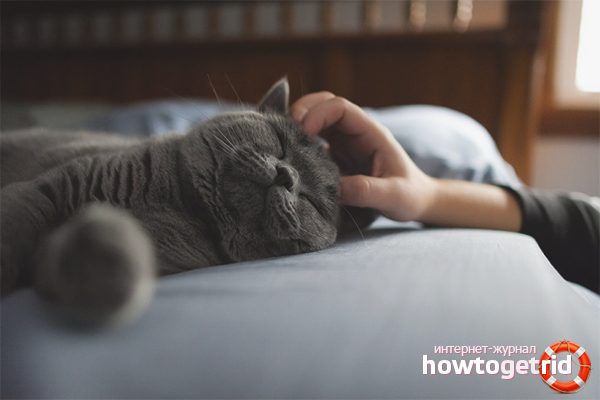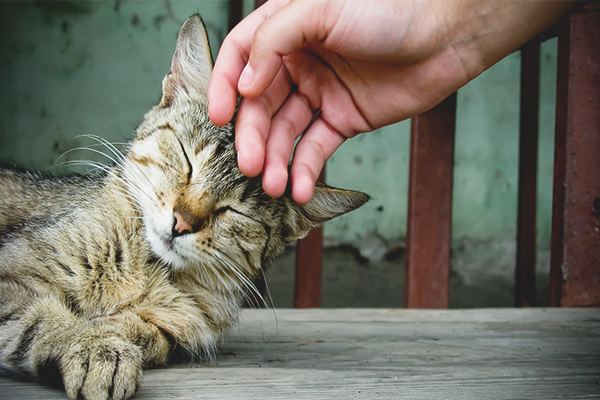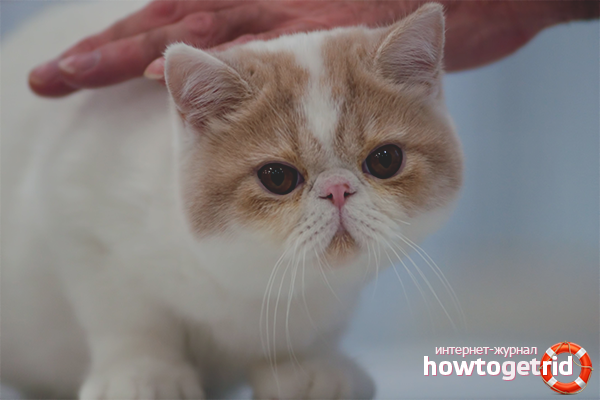The content of the article
Each new owner of a kitten seeks to educate the ward affectionate and playful. The pet will grow as such if the owner will give it due attention. Friendly cats are notable for their confidence, devotion and love for a person, as well as for their patience and affectionate character. To make life easier for yourself and your pet, you need to take your pet on bail from the first days of his stay in the house. Consider the important aspects in order, we give practical advice on the care and education.
Recommendations for raising cats
- Eye contact. The feline family has a negative attitude towards gazing and looking eye to eye. Pets regard this behavior as a challenge, preparing for an attack. Regardless of the age of the cat, do not watch her intently. Watch your pet with side vision, without giving yourself away.If you are looking at the cat in the support, blink smoothly and often, do not keep your eyes open all the time. After the time, the pet will appreciate the changes in your behavior and will want more attention.
- Proper care. A cat will grow affectionate and loving only if it receives the necessary care from the owner. By nature, four-legged friends care about each other. The same darling is waiting on you. The cat will appreciate the actions associated with slow stroking her hair and scratching the neck. Buy a comb, take care of the animal's fur, simultaneously pronouncing gentle words in a quiet voice. If you notice a twitching of the tail, it means that the cat is tired of manipulation. Transfer the procedure to another time. Purring and stifling will tell that the pet is happy.
- Treat delicacy. Take the habit of wearing a pocket in your dressing-gown and keep cat food at hand. You can purchase a package of treats at the pet store or use homemade products based on the preferences of the pet. When the cat comes to you, give her "goodies." Over time, the pet will get used to such actions and will be glad to be nearby. Give out a double portion of treats if the cat jumps into your arms.
- Stroking. When a cat gets used to the owner, his care, constant treat of delicacies, exercise of restraint and patience, she is near more and more often. Be patient, watch the behavior of the animal. If the ward lay with you next, putting his back or neck under the arm, do not stint on stroking. Lightly satisfy the needs of the pet. At the slightest sign of discontent, stop manipulating. Laski should be in moderation.
- Calm and restraint. If you recently brought a kitten into the house, correct your behavior. Animals of this kind are afraid of sudden movements and loud sounds, especially if the person and the terrain do not know them. Let your pet get used to the host. Move smoothly, talk gently and calmly. If possible, you are more often with a cat nearby, it is not necessary to take her in your arms. Let the kitten come to you for a portion of tenderness and attention.
- The focus of caress. The cat family goes long and hard to start trusting the owner. Many owners fail to achieve this even after 2-3 years of living together with a pet.If you do not enter their number, successfully making friends with your darling, follow the recommendations. When the cat comes to you for a portion of tenderness, do not need to grab her in his arms and pull. Sit down beside, scratch your tummy, neck, back. Let your pet rub his face about you, stroke the nose. Do not touch the cat in those places where it is unpleasant (paws, tail).
How to raise a cat affectionate
To make an obstinate pet a pet favorite, you must follow the sequence of actions. Be patient, you will achieve results.
Step number 1. Teach pet to caress from an early age
- To make a cat affectionate, it needs to pay attention from the first minutes of being in a new house. While the baby has not yet grown, take it in your arms slowly and slowly. You often go to rest together, let the kitten sleep while you are watching TV.
- Create for your pet the maximum conditions of safety and comfort, build a stove bench from a plaid or a blanket on the bed. Stroking the cat after waking up and in moments when it only falls asleep. Stay close, but do not impose.
- While the kitten has not grown, wear it on your hands.Lay the child on the forearm, make sure that his legs do not hang down. At first, your main task is to gain trust.
- As the kitten grows up, the character will change. He can become obstinate or surprisingly calm. In the first case, teenage kids often hiss at the owner. Do not pay attention to this behavior, be patient.
- To overcome dislike, rub your hands with cat food and let your pet sniff your fingers. Perhaps he will start to lick them. In this case, always have a treat with you. Treat your baby when he comes closer. Try to carefully reduce the distance between you two.
Step number 2. Do not underestimate the cat's self-esteem
- Every owner of the cat family understands that it is the person in the house that is the leader of the pack. However, in most cases, cats think the same way, so they behave with restraint and detachment.
- You, as the owner of the fourfold friend, do not show your primacy at every opportunity. Such actions only alienate the freedom-loving and self-confident cat.
- It is important at least 1 time in 3 days to give your beloved the opportunity to feel like the main personCats do not obey the owners, because their natural is not provided for such behavior.
- The cat will be affectionate only if it feels confident. Do not confuse obstinate "tigrits" with dogs, the latter will do everything for the love of the owner. Cats, in turn, obey only when they have already established themselves in the role of leader.
- If you scold the pet, he will begin to experience stress. The agitated animal does not perceive any information. Under negative circumstances, the cat tries to defend itself and hide in a corner.
- Do not confuse affectionate animal with a pet, who has become impudent to the edge. The main thing is not to allow yourself to scream at the cat, beat her with your hand or with a newspaper. Give up punishment and coercion.
- Refer to the origins of education. Adults sizzle on kittens when they foul. Do the same. If the cat has done poorly, say a loud "Shhh!" With a good deed, do not skimp on the praise.
Step number 3. Pay attention to the cat constantly

- What is affectionate cat? First of all, this is a pet who sleeps with his master, watches TV with him, meets him from work, hugs and “talks”.If you do not pay attention to the pet, she will withdraw, and will live by itself.
- Do not look for excuses that you do not have time for your pet. Why then did you get the animal? Learn to move away from important matters and spend time with your four-legged friend, if the cat asks for it.
- It is not necessary to start a pet, if you can not allocate for him at least 3-5 hours a day. Kids grow quickly, in the absence of a person nearby, eventually out of a cute pet you get an aggressive, detached, not tame cat.
- However, it is not worth imposing. Even the most loving cat will want to be alone, sweetly snuffing on the sofa or windowsill. Pay attention to the animal when the pet asks for affection.
- As mentioned earlier, cats belong to freedom-loving animals. You should not be surprised if, with the constant violation of your personal space, the pet moves further and further away from you.
Step number 4. Play with your darling correctly
- To date, the shelves of pet shops are crammed with all kinds of toys for cats. Nevertheless, despite the extensive choice, the cat will not be affectionate if the owner himself does not start playing with it.
- Buy brushes, rattles, balls, a house and a scraper. Provide an animal with all necessary.Stand out at least an hour a day playing games with your pet.
- It is strictly forbidden to "poison" the cat with your hands or feet. When the animal begins to show aggression and cling teeth to your fingers, you can forget about a tender pet.
- If in the process of self-indulgence, the ward began to play, clutching your teeth in your brush, stop. With a terrible look, look into the eyes of your pet, start to hiss. So you show your displeasure. Continue to play further, as if nothing had happened.
- Joint hobbies, running around the house and games bring animals closer to people. In the process of pampering, do not shout, try to speak softly and quietly, laugh. Give your mood to the cat.
- Animals of this kind love secluded places. They also prefer to be at the top, watching from a height. Equip for your favorite several places: on the closet, on the back of the sofa, on the ceiling. Buy a house with steps so that the cat has its shelter.
It is difficult to change the already formed character of the cat, so education should be carried out from an early age. Give your pet a lot of time, do not impose. Keep a treat at hand, do not touch your favorite by the tail or paws.Comb the cat's fur, iron the neck and the area behind the ears. Let the ward feel at home, do not underestimate the animal's self-esteem, play with it.
Video: how to rehabilitate a wild cat in affectionate pet












To send